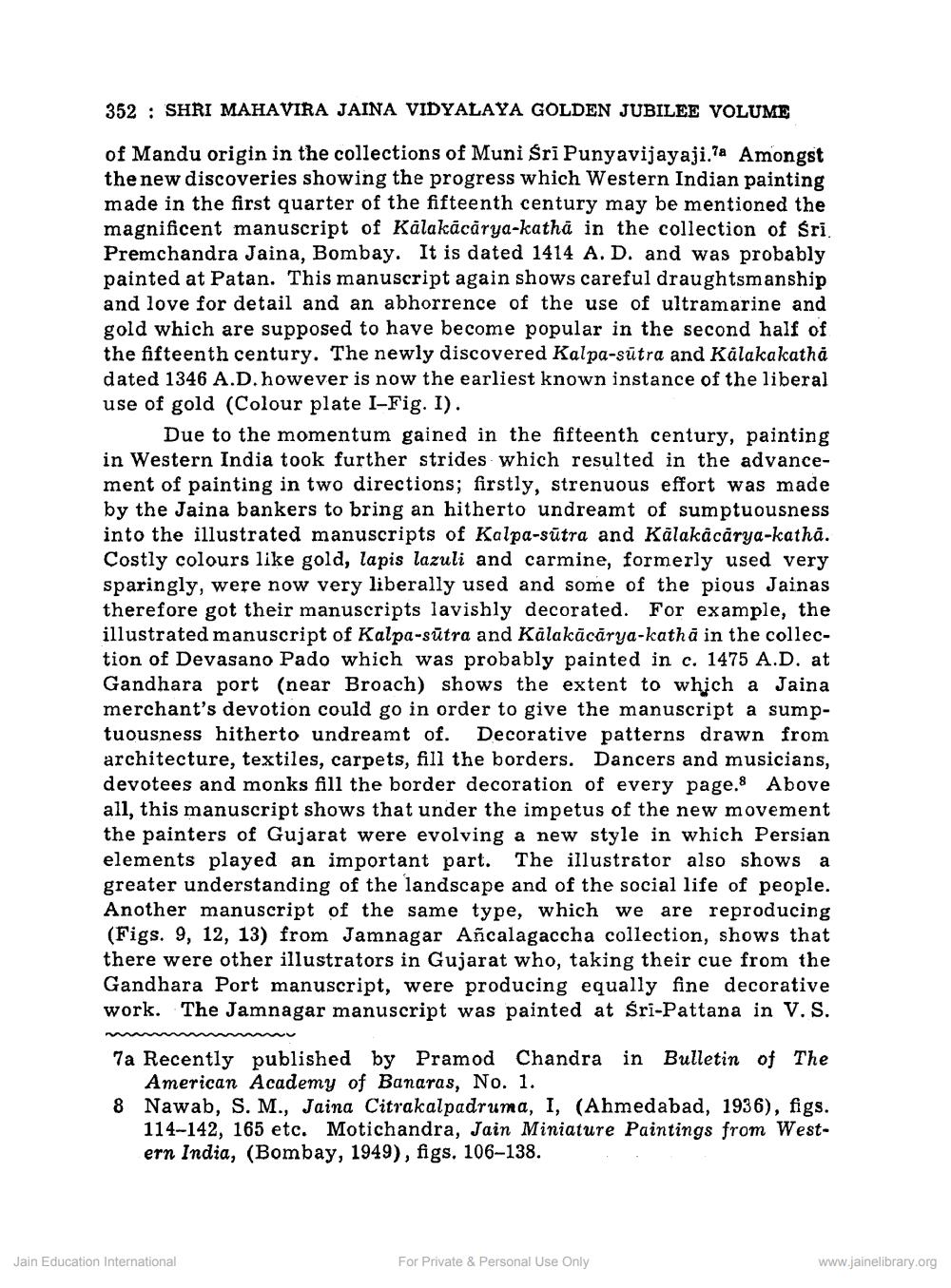Book Title: New Documents of Jaina Paintings Author(s): Moti Chandra, Umakant P Shah Publisher: Z_Mahavir_Jain_Vidyalay_Suvarna_Mahotsav_Granth_Part_1_012002.pdf and Mahavir_Jain_Vidyalay_Suvarna_ View full book textPage 5
________________ 352 : SHRI MAHAVIRA JAINA VIDYALAYA GOLDEN JUBILEE VOLUME of Mandu origin in the collections of Muni Śri Punyavijayaji.la Amongst the new discoveries showing the progress which Western Indian painting made in the first quarter of the fifteenth century may be mentioned the magnificent manuscript of Kalakācārya-katha in the collection of Sri Premchandra Jaina, Bombay. It is dated 1414 A. D. and was probably painted at Patan. This manuscript again shows careful draughtsmanship and love for detail and an abhorrence of the use of ultramarine and gold which are supposed to have become popular in the second half of the fifteenth century. The newly discovered Kalpa-sūtra and Kalakakatha dated 1346 A.D. however is now the earliest known instance of the liberal use of gold (Colour plate I-Fig. I). Due to the momentum gained in the fifteenth century, painting in Western India took further strides which resulted in the advancement of painting in two directions; firstly, strenuous effort was made by the Jaina bankers to bring an hitherto undreamt of sumptuousness into the illustrated manuscripts of Kalpa-sūtra and Kälakåcårya-kathā. Costly colours like gold, lapis lazuli and carmine, formerly used very sparingly, were now very liberally used and some of the pious Jainas therefore got their manuscripts lavishly decorated. For example, the illustrated manuscript of Kalpa-sūtra and Kalakācārya-katha in the collection of Devasano Pado which was probably painted in c. 1475 A.D. at Gandhara port (near Broach) shows the extent to which a Jaina merchant's devotion could go in order to give the manuscript a sumptuousness hitherto undreamt of. Decorative patterns drawn from architecture, textiles, carpets, fill the borders. Dancers and musicians, devotees and monks fill the border decoration of every page.8 Above all, this manuscript shows that under the impetus of the new movement the painters of Gujarat were evolving a new style in which Persian elements played an important part. The illustrator also shows a greater understanding of the landscape and of the social life of people. Another manuscript of the same type, which we are reproducing (Figs. 9, 12, 13) from Jamnagar Añcalagaccha collection, shows that there were other illustrators in Gujarat who, taking their cue from the Gandhara Port manuscript, were producing equally fine decorative work. The Jamnagar manuscript was painted at Sri-Pattana in V.S. 7a Recently published by Pramod Chandra in Bulletin of The American Academy of Banaras, No. 1. 8 Nawab, S. M., Jaina Citrakalpadruma, I, (Ahmedabad, 1936), figs. 114-142, 165 etc. Motichandra, Jain Miniature Paintings from Western India, (Bombay, 1949), figs. 106-138. Jain Education International For Private & Personal Use Only www.jainelibrary.orgPage Navigation
1 ... 3 4 5 6 7 8 9 10
